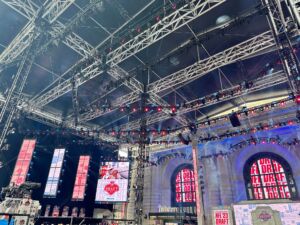Community, Leadership, Experimentation, Diversity, & Education
Pittsburgh Arts, Regional Theatre, New Work, Producing, Copyright, Labor Unions,
New Products, Coping Skills, J-O-Bs...
Theatre industry news, University & School of Drama Announcements, plus occasional course support for
Carnegie Mellon School of Drama Faculty, Staff, Students, and Alumni.
CMU School of Drama
Thursday, September 07, 2023
Solution by Thern: NFL Draft Stage Winches and Controls
Thern® Stage Equipment: Thern was tasked with developing a solution capable of precisely lifting the entire set of truss sections to a height of 100 feet, involving 400 feet of rope spooling, all while maintaining synchronized movement. The winches needed to be integrated into each truss section’s end and remain in place after the lift.
Subscribe to:
Post Comments (Atom)

2 comments:
The article on Thern's NFL Draft Stage Winches and Controls is undeniably fascinating. It offers a glimpse into the remarkable world of engineering problem-solving, showcasing the intricate design and production process behind costume winches and controls. It's a testament to the incredible strides made in technology. As with any engineering marvel, it would have been insightful to delve deeper into the design process. Much like Tait Towers' transparency in detailing their design journey for Rihanna's Super Bowl performance last year, such narratives provide valuable insights. They illustrate the iterative nature of design, where problems arise, are tackled, and solutions evolve over time. This iterative approach is a fundamental aspect of tackling complex challenges like these. Indeed, nobody gets everything right on the first try, especially when dealing with intricate systems. Learning from mistakes and refining designs is an integral part of engineering. It's reassuring to know that there is room for improvement and innovation in even the most intricate and specialized technologies. As technology continues to evolve, articles like these remind us of the ingenuity and dedication that drive advancements in various fields.
What struck me in this article is how almost any goal is possible with enough resources and planning, and especially how important planning is. Throughout this article it was commented how successfully everything was integrated and that can only be done if the planning is well done. You both need engineers to solve individual problems such as how each winch can fit inside a piece of truss and people managing the larger logistical issues like timeframe and integrating different parts of the project together.
I also found the concept of having one large truss grid that moves together as described in this article interesting. Rather than needing to have riggers attach individual sections to the structural steel and access those positions with lifts, you can make a whole grid able to move up and down with only 4 points to secure it. While I am sure it is more complicated than just pushing a button, if the grid needs to come down to troubleshoot a piece of equipment it can.
Post a Comment